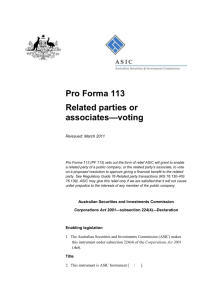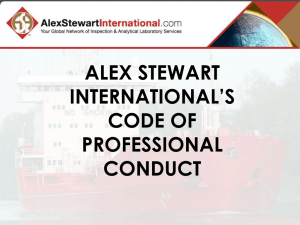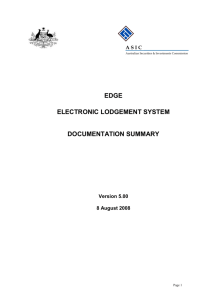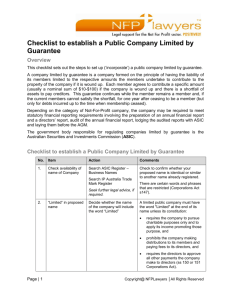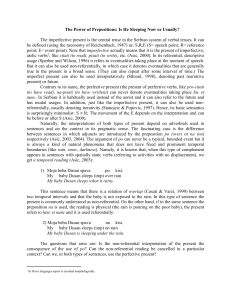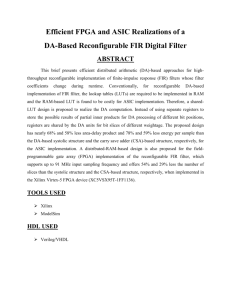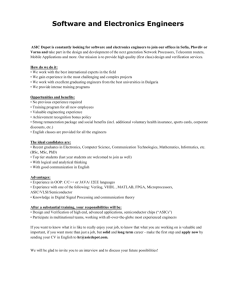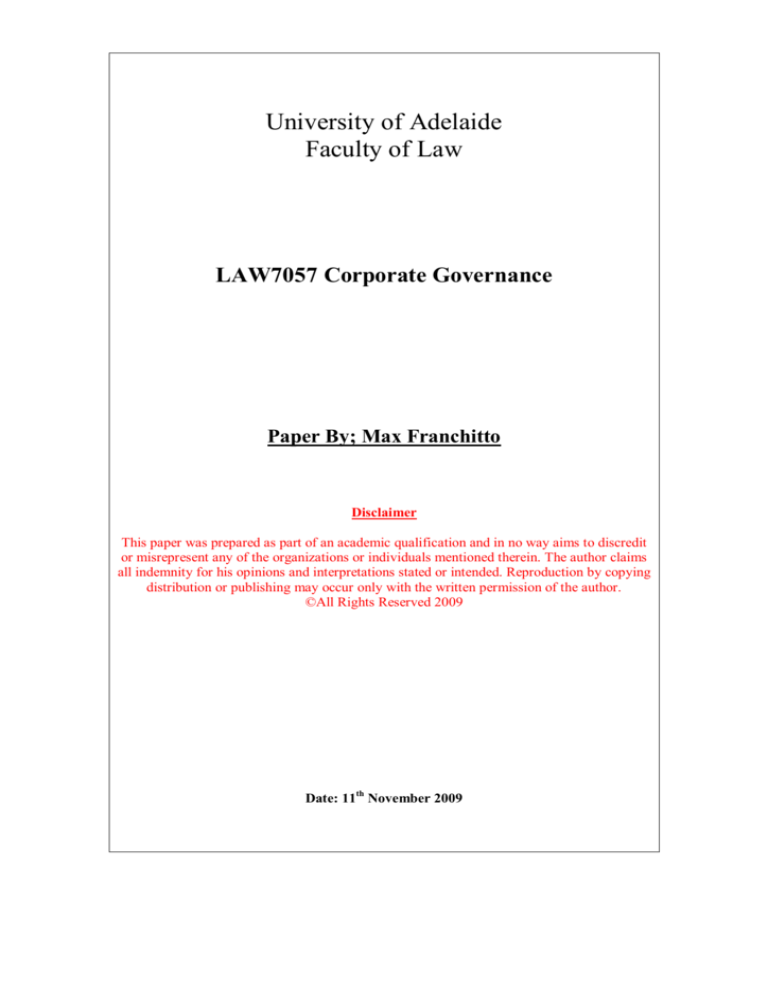
University of Adelaide
Faculty of Law
LAW7057 Corporate Governance
Paper By; Max Franchitto
Disclaimer
This paper was prepared as part of an academic qualification and in no way aims to discredit
or misrepresent any of the organizations or individuals mentioned therein. The author claims
all indemnity for his opinions and interpretations stated or intended. Reproduction by copying
distribution or publishing may occur only with the written permission of the author.
©All Rights Reserved 2009
Date: 11th November 2009
Question: Can the role of ASIC be interpreted as passive or reactive when managing
corporate governance in the financial services sector, given recent collapses in that
industry sector. A discussion with reference to the most recent events.
The role of the Australian Securities & Investment Commission is defined as follows:
“ASIC is the independent Commonwealth statutory body responsible for maintaining,
facilitating and improving the performance of Australia’s financial system and the entities
within that system. It is also responsible for promoting the confident and informed
participation of investors and consumers in the financial system. ASIC regulates Australian
companies, financial markets, financial services organizations and professionals who deal and
advise in investments, superannuation, insurance, deposit taking and credit.”1
In this context ASIC regulates using the following legislation2;
Corporations Act 2001
Australian Securities and Investment Commission Act 2001
Financial Services Reform Act 2001
Insurance Contract Act 1984
Superannuation (Resolution of Complaints) Act 19993
Superannuation Industry (Supervision) Act 1993
Retirement Savings Accounts Act 19997
Life Insurance Act 1995
Medical Indemnity (Prudential Supervision and Products Act) 2003
In parallel with the above legislation ASIC has entered into a Memorandum of Understanding
with the following other regulatory bodies;
Australian Competition and Consumer Commission (ACCC)
Australian Prudential Regulation Authority (APRA)
Australian Securities Exchange Limited (ASX)
Australian Taxation Office( ATO)
Director of Public Prosecutions (DPP)
Financial Reporting Council (FRC)
Members of the Council of Financial Regulators
Reserve Bank of Australia (RBA)
The importance of the above lists will be revealed in the discussion to follow, but it must be
said that this list clearly defines the reach of ASIC as a regulator and the consequential
influence it has and has had in the market place.
1
2
ASIC preamble in a public advertisement seeking members to ASIC [AFR 30/10/09]
ASIC website; www.asic.gov.au/asic/About ASIC/The laws ASIC administers
Max Franchitto Student No: 1196885/ Law Faculty/Masters Assignment/
2
This body of work will focus on the role of ASIC and the breaches of duty by various
corporations and their Officers and Directors, within the context of specific legislation
namely;
Corporations Act 2001
Australian Securities and Investment Commission Act 2001
Financial Services Reform Act 2001 (FSR Act)
Trade Practices Act 19743
It is intended that the discussion in this work will deliver sufficient evidence to draw a
conclusion as to whether ASIC has performed sufficiently well in the delivery and
administration of its regulatory powers as defined in the ASIC Act 20014.
The role of ASIC in the last four years has been intensified by both Ministerial and Public
scrutiny, this has then been accentuated by Consumer groups and their supportive legal
advisors into questioning ASIC’s effectiveness in keeping ethical and responsible those who
have either mislead investors and caused them to suffer losses or indeed have actively
misappropriated their invested funds.
This paper also considers what role does ASIC have in monitoring the public reporting
processes of collapsed organizations, in particular the fact that in some cases they managed to
submit misleading financial reports. Furthermore these organizations have been a challenge to
ASIC as far as the manner in which they operated, which was not always within the Corporate
Governance requirements of conducting a properly managed business5.
This will be magnified as we look at the mismanagement of finances and the consequential
losses to investors to whom the gravity of the situation was misrepresented6.
Moreover we will need to explore the role of ASIC within its regulatory framework and its
capacity to deliver in light of Financial Services Reform7, particularly in reference to the
ordinary small time investors seeking financial advice8.
This regulatory framework had its beginnings in 1999 with the introduction of the FSR Bill
which was then passed as an Act and was introduced, after much industry consultation and
feedback, on March 12th 2001. This was a great leap forward from the reforms suggested by
the then Minister for Financial Services Joe Hockey, known as CLERP9. It was in this
evolutionary process as a driver of legislation that ASIC, I believe, began to play the hybrid
role of compliance coach and educator to what was then a suspicious and reluctant financial
services industry. This first foray into what the industry considered was onerous legislation
3
TPA not within jurisdiction of ASIC, however significant in the prosecution of some cases.
ASIC Act 2001 (Cth), S1, S8,S11,S12A, powers and reach therein defined.
5
Corporations Act 2001, Part 2.1D Duties & Powers S180 to S185, in general
6
Centro Properties, Centro Property Trust and Centro Retail Trust will be the focal example.
7
FSR Act 2001 (Cth)
8
Storm Financial and Westpoint will be focal examples.
9
CLERP was the first major step toward altering the financial planning environment.
4
Max Franchitto Student No: 1196885/ Law Faculty/Masters Assignment/
3
impacted the industry greatly and we saw many well publicized exits by small and large firms
in the industry. Many thought that FSRA was overkill for the industry and would get in the
way of giving investment and financial planning advice to clients, who after all were seeking
simplicity not complexity in the advice & products they were buying into.
In the period between 2004 and 2009 (timeline of this paper) ASIC has been under the
spotlight for its role not only as a regulator but also as an enforcer of those regulations. It has
had a great many critics ranging from financial planning bodies such as the FPA10 to
Corporate Law advisors and Financial Services License holders11 and their respective lobby
groups.
It has on a number of occasions exercised its powers under s50 of the ASIC Act 12 as a
consequence of acting upon breaches with considerable public exposure.
Who collapsed and why they did;
Generally all of the collapses in the period of 2004 to 2009 of financial products or financial
entities have come about because of a severe abuse of the “business judgment rule”13 as
interpreted by the Corporations Act. This is basically the obligation of a Director or Officer of
a corporate to manage the business in the best interest of its shareholders and stakeholders
with regard to risk, losses and profits in a balanced manner 14.
The first of the notable collapses that I would like to review is Centro Properties (all its
related entities included)15, where not only did a corporation suffer losses due to inadequate
Corporate Governance but also as a result of it being an ASX listed entity a great many
individual and Institutional investors incurred severe losses though the plummeting of its
share price.
The share price fell in March 2009 from $10.06 to $0.04 due to the company not being able to
manage its debt driven strategy to grow globally and overpaying for assets in the USA16. The
company collapse resulted from a misstated balance sheet disclosure whereby current
liabilities were expressed as non current liabilities and the said debt was due for re-financing
from short term to long term loans, however the Directors and Management were not
adequately prepared, this was compounded by the effects of the Global Financial Crisis
(GFC) which was evolving at the time.
10
Financial Planning Association of Australia, represents Financial planner giving advice as CFP’s
Certified Financial Planner an education based accreditation.
11
Dealer Groups who own CFP firms or offer franchise arrangements and Fund Managers who
produce many of the investment products offered by such planners.
12
ASIC Act 2001, s50, “ASIC may cause civil proceedings to be begun’
13
CA 2001 s180
14
Discussed in various corporations literature and paraphrased by writer. S180 CA duty of care skill &
diligence.
15
Centro Properties, Centro Property Trust and Centro Retail Trust
16
Namely the United States REIT and New Plan Realty purchases in 2007
Max Franchitto Student No: 1196885/ Law Faculty/Masters Assignment/
4
Centro like many other financial managers was working in a booming economy where
growth, and rapid growth at that, was considered a measure of success. In this case the ascent
by Centro was based on high levels of debt in what started as a low interest market with
generous lenders. In other words the capital raising market was blissfully proactive.
Corporate Governance aspects of collapse;
The buoyant market gave rise to creative accounting whereby Directors and CEO’s alike who
dared, could push profit margins and share prices up by using sophisticated financial
engineering, which was made famous by another collapsed entity and its founder in Allco
Finance (David Coe- Executive Chairman)17.
But in the case of Centro the failing was not as sophisticated as first thought and in fact it
came about as a result of bad auditing by PWC18 and a willingness by Directors to sign off on
such poor standards of work.
Centro directors it is alleged, knew full well what constituted current and non-current
liabilities and therefore have little or no grounds to claim reliance on expert opinion. In fact it
was the Directors and the CEO who held a strong appetite for debt funded growth during a
buoyant market.
The CEO of Centro (Mr. Andrew Scott) was granted interest free loans (of $10.5m)19 to buy
Centro shares with a loan agreement stating that the loan was not repayable if the share price
was to collapse. This has non-disclosure and conflict of interest has its fundamental flaw. Mr.
Scott had no risk in his concept of rapid growth for the group and he was safe in his thinking
that his losses were limited.
The intent to mislead investors was escalated in a quote from the CEO during a newspaper
interview20 wherein Andrew Scott said “the Board considers the organisation is still solvent
and that remains so at least until the completion of the February review’, the review he was
referring to was to be conducted internally on the state of its finances and debt levels. In that
same interview he blamed the collapse of the sub-prime market for their problems in short
term funding. That review revealed the incorrect financial reporting as a fact, with reasonable
assumption, that Mr Scott must have been aware of this as CEO. The club like nature of the
Board (a board made up of like minded people with previous relationships with one another)
and what seemed to be total trust for Mr Scott was another strong indicator for regulators to
look closer.
The irony of the misconduct in this case is that there is no law against over paying for an asset
or even having to borrow excessively in order to do so, but reporting to misstate and therefore
mislead stakeholders and shareholders is a breach, simply because disclosure in financial
statements must be full and completely transparent.
17
Allco Finance collapsed in 2008 due to such a concept and misstated financial reports
Price Waterhouse Coopers were the auditors and have been named in the class action pending
19
The Australian, article by Anthony Klan , Jan 15th 2008
20
The Australian, John Durie article on 17th December 2007
18
Max Franchitto Student No: 1196885/ Law Faculty/Masters Assignment/
5
ASIC in its actions alleged that Centro’s directors failed to comply to perform their duties
with due care and diligence in their approval of the financial reports for the whole of the
Centro Group. They in fact were negligent by not correcting or questioning what seemed to be
gross misstatements, in particular the relevance and amount of interest bearing liabilities (debt
funding as stated earlier), which were wrongly classified as non –current liabilities21. This in
itself was no small matter as it involved an amount of some $1.54 Billion which were current
debts as at 30 June 2007. ASIC has gone forward by exercising its rights under s50 of the
ASIC Act and has taken civil action against the Directors and Officers at the centre of this
debacle.
Centro Directors are not being charged for mismanagement or poor business judgment but in
fact are in trouble because they provided inaccurate and misleading information to
shareholders in their duty to disclose.
The action now taken by ASIC is post collapse and I would submit that ASIC should have
been part of the February internal review22 of the company debts and finance levels or at least
asked to see any reports coming from such reviews, and not wait till the tabled financial
accounts from PWC. In its role as regulator ASIC would have had every right to get involved
immediately. The broker fraternity had been heavily criticizing Centro and its Board for the
“lack of disclosure to the market about gearing levels, particularly given the current parlous
state of credit markets”. 23 Brokers went on to comment that in one week Centro’s market
value plummeted from $4.8billion to $1.35 billion after having reached an all time high of
$10billion in May 200724. Again, another reason for ASIC to demand answers25. This in fact
has shadows of the HIH debacle, where many knew something was not right but no one
moved to do anything about it.
ASIC Passive or Reactive is a question worth asking in light of the above discussion,
because in fact ASIC did come into the picture purely as an observer at first and only when
the damage was done and investors lost considerable value of their investments, it moved to
sanction the misleading statements of the Board. In this way and in this case ASIC was not
totally passive but can be said was reactive after the fact.
ASIC is now seeking recourse on all of the Directors26 plus the CEO and the CFO for their
negligence27. Further to that it has not ruled out taking civil action against auditors Price
Waterhouse Coopers as they also failed to adequately disclose the debt levels in their 2007
audit. Their role, as with any auditor, is to independently verify the accuracy of the financial
21
ASIC , Media Centre Press release 09-202AD at www.asic.gov.au at 21/10/09
Referred to in John Durie article in The Australian, 17Dec 2007
23
Sydney Morning Herald, Business page article on 17th December 2007
24
Op cit. article 17th December 2007
25
CA 2001 s247A
26
Listed in ASIC Media Release 09-202AD 21st October 2009
27
The first hearing on the matter will be November 2oth 2009 in the FCA
22
Max Franchitto Student No: 1196885/ Law Faculty/Masters Assignment/
6
statements prepared by companies- a duty clearly enshrined in the Corporations Act.28 The
action against PWC is justified and will by all reports proceed. The level of success remains
undetermined at this date.
ASIC now seeks to implement similar sanctions to those in the James Hardie case with
Director disqualification and heavy monetary penalties, criminal prosecution is unlikely as
civil action is likely to yield greater success, a strategy repeatedly used by ASIC. Reliance on
auditors as an argument to defend the Directors is at best shaky as they should have been
skilled and informed enough to detect issues.
The second of the notable collapses that I would like to review is one of the first corporate
governance related collapses in the financial services sector to cause major losses to retail
investors. The collapse of Westpoint a Western Australian based financial services company
investing once again in property, was a mezzanine finance based collapse and it first attracted
ASIC attention in 200429. It was then noted that the company was marketing its product via a
select group of financial advisors, in return for fairly high commissions 30 on sales made. The
money was mainly invested through mezzanine products which lure investors with higher
rates of return than normal, but at the same time ranks them well down the list of creditors in
the case of a collapse. At the time Mr Lucy was quoted as saying “it is not up to ASIC to say
whether such commissions are too high, but only to ensure that they are duly disclosed to
investors”31, his message to investors was that they remain vigilant of such products and
management fees.I recall that financial planners and accountants flocked to Westpoint and
actively promoted its benefits based on reports issued by the company via its Directors and
Management. Some 4,300 investors were attracted to the product and it raised some $393
million of funds to be invested in a number of Mezzanine projects as identified by ASIC 32as
at January 2006. Claims for losses were likely to be up to $245m.
Corporate Governance aspect of collapse;
This was a case of blatant breach of duty of care as defined in the Corporations Act. The
Directors and officers as trustees of these investment vehicles failed to disclose, with
accuracy, the gearing levels of each project and the risks which that gearing represented.
Further more another auditor was brought into the negligence action when it became apparent
that KPMG was negligent in its conduct of the audits in the Westpoint Group as well as each
of the eight (8) Mezzanine projects. This was a repeated breach of duty.33 The Directors and
28
CA 2001 (Cth) s307 through to s312 clearly sets out duties
The commissioner at the time was Jeffrey Lucy reputed more aggressive then D’Aloisio
30
Commissions to advisers and the company were as high as 10% of the amount invested, normal
being 1-2.8%.
31
This is part of the Statement of Advice requirements with FSR Act 2001.
32
ASIC Media release 07-291 ASIC to pursue compensation, issued 8th Nov 2007.
33
CA 2001 Auditors Duties s307 to s312 op.cit.
29
Max Franchitto Student No: 1196885/ Law Faculty/Masters Assignment/
7
Officers were also in breach of the Corporations Act in as so far that it was established that
they continued to operate the Westpoint Group while it was insolvent and were fully aware of
that fact. In so doing they also breached FSR Act as they operated the schemes via entities
which did not hold a financial services license.
ASIC in its actions34 has moved to pursue KPMG for a breach of its duty of care in
performing as an auditor, while also pursuing each of the eight Mezzanine companies that
were managed by Westpoint Group35 , the latter are being prosecuted for misleading
disclosure of financial reports and for operating an insolvent company which was clearly
evident once inter company loans and the use of a group “treasury model’36 to disguise
shortfalls became public knowledge.
All of the five Directors have been prosecuted under s50 of the ASIC Act with notable press
and unfortunately little was recovered in the first attempt as they all filed for bankruptcy, as a
means of protection. This is bad news for the investors more so than for ASIC.
The role of ASIC is open to question in relation to the Mezzanine finance schemes have been
prevalent in the Australian economy for some considerable time. They have attracted
particular attention in recent years only because they have been promoted via financial
planners/advisors and accountants at a consumer retail level. So ASIC chairman D’Aloisio
“[ASIC] sees a clear public interest in using its powers to pursue compensation for the benefit
of Westpoint investors”.37 Once again given the high profile of these schemes in the financial
services sector one has to question why ASIC has acted in recovery mode rather than
prevention. The FSR Act does monitor the behaviour of advisors and their licensees and in
fact in this case one such advisor38 received a 12 month suspended sentence while another in
WA39 is currently the subject of civil proceedings to recover $14m of lost investor funds.
The third and final of the notable collapses is Storm Financial Limited. This firm was placed
into liquidation by order of the Federal Court on 26th March 2009 and Worrels Forensic
accountants appointed as liquidators, CBA ( Commonwealth Bank) with which Storm had
dealings also appointed KordaMentha as liquidators at about the same time.
The story here is basically that the two Directors Emmanuel Cassimatis and Julie Cassimatis
are both Directors of Emmanuel Cassimatis & Associates Pty. Ltd and associated company
Storm Financial Limited. In their role as Directors, it is alleged that they, firstly failed in their
duty of care as Directors in advising regulators that the company was in the brink of financial
34
ASIC Act s50 op.cit
Directors and Officers of holding company are repeated in each of the mezzanine companies.
36
This concept in plain english is an accounting method that uses one set of funds on balance sheets of
numerous entities.
37
ASIC Media release, 08-207 at op.cit 13th October 2008
38
Neil Burnard in District Court of NSW – for promoting Westpoint with misleading non disclosure
39
Brighton Hall Securities - as per ASIC Media release 09-194AD, 7th October 2009
35
Max Franchitto Student No: 1196885/ Law Faculty/Masters Assignment/
8
collapse as a result of pending margin calls on leveraged loans granted by CBA and in smaller
amount by Bank of Queensland40. These loans were geared against properties owned by their
investor clients to whom they also owed a duty of care and disclosure ( in their position as
financial advisors). It is further alleged that the Directors transferred an excessive amount of
funds41 to their holding company and then intended to transfer them to their family trust. The
Directors failed in their duty to disclose to clients that margin lending loans had the potential
to be called up should the value of the underlying investments drop below a given level,
hence creating a real loss to investors as opposed to a paper loss, as loans would have to be
repaid at call to the banks.
The severity of this collapse rests in the fact that the majority of clients were middle class
investors who offered their homes as security against the margin loans they then used to make
equity investments. The collapse of the value of their shares triggered the margin calls and
hence the financial calamity, which led to financial distress as a result of forced selling at
bottom of the market..
Corporate Governance aspect of collapse;
These breaches relate to both the Corporations Act and the FSR Act.
In the first case there was misleading information about the financial position of the company.
The type of breach involves withholding critical information from stakeholders as to the
imminent risk of their investment. The legitimacy of the call has been a subject of complex
debate which is beyond the scope of this paper42. The duty of Directors was to ensure that the
financial advice they were promoting included full and ongoing disclosure and appropriate
risk management. They failed in that duty and consequently investors have lost large amounts
of money as equity markets collapsed and margin loans were called up. Remembering, that
the majority of investors were middle class Australians, who had in most cases, taken out
mortgages as security against the said margin loans. Pressure from these groups has
demanded that ASIC perform as a regulator and enforcer.
ASIC in its actions, has chosen to pursue the Storm and its Directors in particular with
regards to misappropriation of funds post announcement of losses 43 and the demise of funds
relating to some 3,000 clients. The investigation as been going since that announcement and
has yet to have definite conclusions, however ASIC has not been silent in its intent. In
February 2009 ASIC obtained Supreme Court44 (Qld) orders to freeze a payment of $2million
40
Many of these loans were based on Low Documentation criteria and approved with limited
serviceability testing.
41
Estimated at $2m just prior to the collapse
42
CBA and Storm Financial are at odds as to whether the margin call was premature and implemented
without due care by the Bank, similar applies to BoQ.
43
ASIC Media release, AD08-89 Storm Financial at 24th December 2008
44
ASIC Media release, AD09-11 Storm Financial at 4th February 2009
Max Franchitto Student No: 1196885/ Law Faculty/Masters Assignment/
9
which was transferred from a bank account of Storm Financial Limited on 15th December
2008, as payment to the Directors of that company, via their family Trust.
In March 2009 ASIC used its statement on Storm Financial to a recent parliamentary
hearing45 to warn that its interest in Storm would be likely to have more far reaching
implications for the rest of the financial services industry. ASIC was adamant that its
investigations would not only work to compensate Storm investors but would also be a basis
from which to provide guidance for the future of the financial advisory industry. One would
assume from this that ASIC is asking whether the problems found in Storm could be extended
to other financial services providers, in particular it (ASIC) was quoted as saying “it has
concerns with aggressive leverage models being more widely used in the industry”.46
ASIC passive or reactive, is in question again, in the aftermath of Storm it has been
proactive in providing more resources47 to investigate leveraging models in finance. It has
been active in taking some corrective actions but as always comes in once the damage has
been well and truly done.
The CBA has been very vocal in its criticism of ASIC in this regard; particularly given that it
is also a focal point of investigation for ASIC (in the Storm case). What the CBA is asking is
for ASIC to consider being proactive in performing “risk analysis” on AFSL models 48. The
CBA has made recommendations to a parliamentary enquiry49that AFSL’s be required to
report to the regulator on various aspects of their businesses. This should have been an
initiative from ASIC long ago, when instead it chose to over regulate the giving of advice
process through FSRA. I am in agreement here as I see advisory firms as corporate businesses
first and advisors second, hence they have a duty to proper Corporate Governance.
CBA has exposed ASIC as reactive in this case in that it has chosen to name the corporate
regulator along with itself and Storm the key stakeholders involved in the circumstances
leading up to the hardship suffered by investors.50
In this case again ASIC has come along in the aftermath as a regulator choosing to prosecute
rather than prevent.
Opportunity gaps for ASIC are many and varied and not only in the context of the cases
discussed thus far. This is made more evident by a recent statement from ASIC Chairman
Tony D’Aloisio51 that the regulator will “inevitably only step into play after a company
collapse has occurred”, is this the best use of such a regulator?
45
Reported in Money Management Issue No.7 March 5th 2009 to Senate Standing Committee on
Economics, pg.4
46
Wetspoint was in fact a wholesale version of this retail problem
47
ASIC 2008-09 Annual Report, at www.asic.gov.au , Pg 58 “increased numbers in Financial
Economy Teams”
48
Australian Financial Services Licensee
49
Bernie Rippol MP, “Parliamentary Joint Committee on Corporations and Financial Services” 2009
50
Money Management Issue No.29 13th August 2009, P.13
51
Reported in Money Management Issue No. 29 op.cit Pg.13
Max Franchitto Student No: 1196885/ Law Faculty/Masters Assignment/
10
In a subsequent article52 criticism was again leveled at ASIC by commentary that Governance
principles should become the foundation for obtaining a license (AFSL) to distribute and
advise in financial services products. The submission makes claims that the existing
regulatory regime encourages a tick-the-box approach to compliance without promoting and
ethical culture which emanates from having to comply with the Corporations Act and its
corporate governance principles. Its recommendation is that financial services organizations
be made to build and maintain procedures that are fully in line with Corporate Governance
Principles53.
The question I pose is who would challenge ASIC if it was to stretch the Corporations Act
into the FSRA legislation and in so doing used both to take up a more “interventionist”
approach to the issues that led to the financial collapse of Westpoint and Storm and even
Centro.
ASIC has made a submission to the Joint Parliamentary Committee (JPC) canvassing
legislative and regulatory changes that would actually see it take a more “interventionist”
approach. In that submission ASIC believes that the long term benefits of increased market
intervention might significantly outweigh the deficits.
In defense of its role thus far it has stated in its submission54 “ASIC, has within the regulatory
framework, discharged its responsibility effectively and efficiently” nowhere in that
submission has it admitted that it was always within its discretion to interpret the legislation
or its role as a regulator to be more pro-active.
One of ASIC’s plans to help investors avoid future calamity is to introduce the concept of
“swimming between the flags”55 thereby guiding investors not to venture too far outside the
conventional investment product range ( ASX, bank deposits, managed Funds) and seeking
appropriate advice. Hopefully this informative program will make investors less likely to get
involved in risky investments.
ASIC could also deliver more effort and control in promoting a stronger “disclosure focus”56
which has been exposed as a major gap in the fallout from the Global Financial Crisis. I tend
to agree with this approach, as it seems that non disclosure or at least wrongful disclosure has
been the root cause evil of a great many of the collapses of the last decade.
ASIC has submitted to the JPC that in an effort to increase its reach and ability in dealing
with issues before they occur it be allowed to consider such extensions to its powers as;
52
Money Management issue No.30 20th August 2009 Pg.6 based on comments filed by Argyle
Lawyers to the Joint parliamentary Enquiry
53
MM op.cit.
54
ASIC submission to “Joint Parliamentary Enquiry”, op.cit 2009
55
Mr Jeremy Cooper, Deputy Chairman ASIC, “Investing in 2009” speech at Naval Military and Air
force Club Adelaide 11th March 2009
56
Ms Belinda Gibson , ASIC Commissioner paper delivered to AICD Conference 2009
Max Franchitto Student No: 1196885/ Law Faculty/Masters Assignment/
11
Ability to move to strike or remove an AFS license when it believes a “breach" may
occur.
Implementation of finance resources requirements as part of obtaining an AFSL,
showing solvency strength and reserves (as Banks do with the RBA).
Ability to ban individuals involved in a breach of obligations by another person,
deleting the safe haven of associated entities.
Clarifying the duty of care owed by advisors to act in the best interest of the client
and not their own.
The prevention and removal of remuneration structures that might create conflicts of
interest57
These suggested reforms are by no means extensive and conclusive but could go a long way
toward strengthening the preventative role of ASIC in future collapses.
In conclusions it is clear to see that a “watch and wait” for a collapse approach is less than
adequate for any regulator, especially given the growing numbers of special financial
instruments and financial products.
It is therefore imperative that ASIC as the cornerstone regulator of the regulatory regime for
entities dealing in financial services and markets be proactive at the very front end of the
process and take up a more preventative role as opposed to one of remedy after the fact.
It seems to me that even escalation to civil and onto criminal proceeding seems to do little for
the greed and deception growing out of the financial markets, especially in times of boom.
Retail and institutional investors need to be able to find security and at some reliability in the
fact that ASIC is monitoring processes early on and not playing a role pure post disaster.
One of the basic rules taught in financial services to managers is to “manage risk as early as
possible no matter how remote it may seem”.
00000____00000
57
This was a driving factor in the majority of financial services collapses between 2005-2009
Max Franchitto Student No: 1196885/ Law Faculty/Masters Assignment/
12
Bibliography:
1. Website of ASIC at www.asic.gov.au , Media Centre, About ASIC and Other.
Media releases as coded in footnotes to paper, various.
Speeches Portal of ASIC 2008, 2009 listings.
2. Professor Bob Baxt AO, “Duties & Responsibilities of Directors and Officers” 19th
Edition, 2009, AICD.
3. Farrar John, “Corporate Governance, Theories, Principles & Practice” 3rd Ed Oxford
University Press.
4. Bevan Christopher, “Corporations Law” Nutshell Edition, 6th Ed., Thomson Lawbook
Co. 2009
5. Corporations Act 2001 (Cth)
6. ASIC Act 2001 (Cth)
7. Financial Services Reform Act 2001 (Cth)
8. Money Management Publications Vol 22. Issues 1-35 2008, Reed Business
Publications NSW Australia
9. Money Management Publications Vol.23. Issues 5- 39 2009, Reed Business
Publications NSW Australia
10. Jeremy Cooper, Deputy Chairman ASIC, “Helping Retail Investors”, 2009 SPAA
National Conference Adelaide, 11th March 2009
11. Jeremy Cooper, Deputy Chairman ASIC, “Investing in 2009” Address to naval
Military and Air Force Club of SA (inc) 11th March 2009
12. Bernie Ripoll MP, parliamentary Joint Committee on Corporation and Financial
Services, 26th February 2009, Media release.
Max Franchitto Student No: 1196885/ Law Faculty/Masters Assignment/
13


